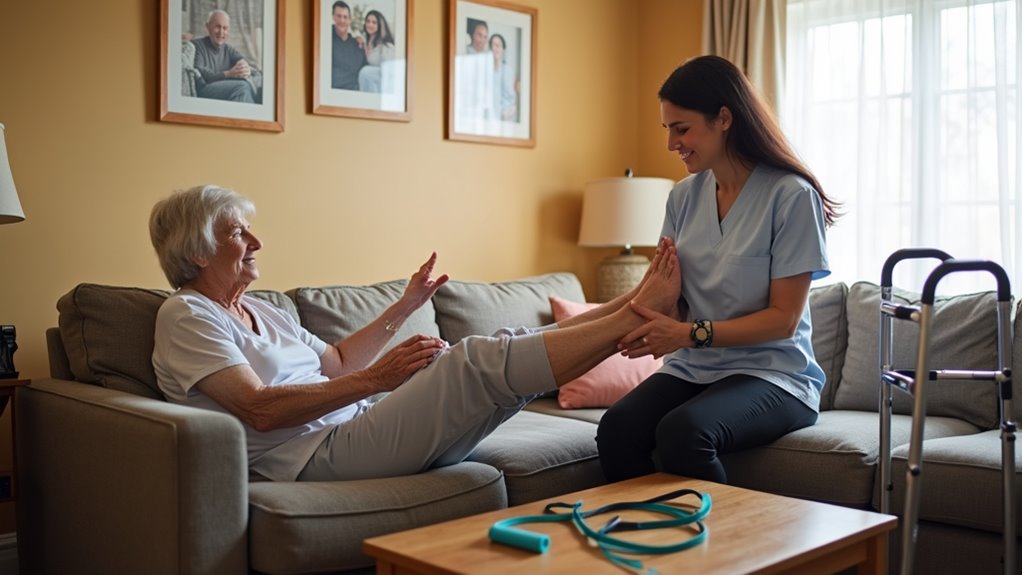Home health physical therapy brings professional rehabilitation directly to your residence, allowing you to recover from injuries, surgeries, or chronic conditions in familiar surroundings. You’ll receive personalized treatment plans that incorporate your home environment and daily routines, with therapists focusing on improving your strength, balance, and mobility. Medicare, Medicaid, and private insurance often cover these services when medically necessary. Understanding the full scope of home health PT will help you make informed decisions about your recovery process.
Key Takeaways
- Home health physical therapy provides professional rehabilitation services in your residence, eliminating transportation needs while offering personalized care.
- Licensed therapists evaluate your home environment, physical condition, and create customized treatment plans during 60-90 minute initial visits.
- Services typically focus on improving strength, balance, and mobility using familiar furniture and spaces within your home setting.
- Medicare, Medicaid, and private insurance often cover home health physical therapy when deemed medically necessary with proper documentation.
- Treatment is particularly beneficial for post-surgery recovery, chronic conditions, or patients with limited mobility and fall risks.
What Is Home Health Physical Therapy?

Home health physical therapy brings professional rehabilitation services directly to patients in their residences. This specialized form of care allows you to receive treatment in your familiar home environment while recovering from surgery, injury, or managing chronic conditions. Your physical therapist will assess your needs and develop a personalized treatment plan using rehabilitation techniques that work best in your living space.
During home therapy sessions, you’ll learn exercises and movements that improve your strength, balance, and mobility. Your therapist will also evaluate your home setup and recommend modifications to improve your safety and independence. They’ll teach you and your caregivers proper techniques for daily activities like getting in and out of bed, climbing stairs, or using assistive devices. This convenient approach guarantees you receive consistent care while maintaining comfort in your own home.
Benefits of Receiving Physical Therapy at Home

Receiving physical therapy in your residence offers numerous advantages that improve your recovery process. You’ll experience personalized care as your therapist adapts treatments to your specific home environment and daily routines. This customization helps you achieve improved mobility while using your own furniture and living spaces.
Your therapist can identify potential safety hazards and suggest modifications to prevent falls or injuries. You won’t need to arrange transportation or navigate challenging weather conditions, which is particularly beneficial if you have limited mobility or live in a remote area. Home-based therapy also allows your family members to participate in your recovery experience, learning proper assistance techniques and understanding your exercise program. Furthermore, you’ll feel more comfortable practicing therapeutic exercises in familiar surroundings, which can lead to better compliance and faster progress.
When to Consider Home Health Physical Therapy

When should you seek physical therapy services at home? You’ll want to evaluate home health PT when you meet specific indicators for intervention and patient eligibility requirements that make traveling to an outpatient clinic challenging or unsafe.
| Medical Conditions | Mobility Status | Living Situation |
|---|---|---|
| Post-surgery recovery | Bed-bound | Limited transportation |
| Chronic illness | Use of walker/wheelchair | Lives alone |
| Neurological disorders | Fall risk | Rural location |
| Acute injury | Balance problems | Homebound status |
Your doctor may recommend home health physical therapy if you’ve recently been discharged from the hospital, experienced a significant decline in function, or need rehabilitation but can’t safely leave your home. Medicare and most insurance providers require you to be “homebound” to qualify, meaning leaving home requires considerable effort or assistance.
What to Expect During Your First Visit
During your initial home health physical therapy session, a licensed PT will conduct a thorough evaluation lasting approximately 60-90 minutes. The therapist will review your medical history, current medications, and specific concerns that led to your need for home therapy.
Your PT will perform an initial assessment of your strength, balance, mobility, and functional abilities. They’ll evaluate how you move around your home, including getting in and out of bed, using stairs, and managing daily activities. They’ll also check your home environment for potential safety hazards.
Together, you’ll establish therapy goals based on your needs and lifestyle. Your therapist will then create a personalized treatment plan, demonstrate exercises, and provide education about your condition. You’ll receive instructions for exercises to practice between sessions and guidance on using any necessary assistive devices.
Insurance Coverage and Payment Options
Most home health physical therapy services are covered by Medicare, Medicaid, and private insurance plans when deemed medically necessary. You’ll need to verify your specific insurance policies to understand coverage limits, co-payments, and any prior authorization requirements.
If you’re not fully covered by insurance or are self-paying, many home health providers offer flexible payment plans to make treatment more affordable. You can discuss these options with your provider’s billing department before starting therapy. They’ll help you understand:
- Your deductible amount
- Required co-payments
- Number of covered visits
- Out-of-pocket maximums
- Payment plan terms
Remember to keep detailed records of all your expenses and communications with your insurance company, as you may need this documentation for reimbursement or tax purposes.
The Role of Caregivers in Home Health PT
Caregivers play an essential role in supporting patients’ success during home health physical therapy. Understanding caregiver responsibilities and implementing effective communication strategies will help enhance your loved one’s progress during treatment.
- Attend therapy sessions to learn proper assistance techniques, exercise modifications, and safety precautions specific to your loved one’s condition
- Help maintain a consistent exercise schedule between PT visits, ensuring exercises are performed correctly and safely
- Document changes in the patient’s condition, pain levels, or concerns, and communicate these observations to the physical therapist
- Create a safe environment by removing hazards, organizing necessary equipment, and implementing recommended home modifications
Tips for Maximizing Your Home Therapy Success
A successful home health physical therapy program extends beyond caregiver support and requires active patient participation. To enhance your progress, focus on consistent goal setting with your therapist, establishing both short-term and long-term objectives for your recovery. Keep a daily log of your exercises and any challenges you encounter.
Develop effective communication strategies with your physical therapist. Don’t hesitate to ask questions, express concerns, or request clarification about your treatment plan. Make necessary modifications to your home environment as recommended, and follow safety guidelines precisely. Schedule your therapy sessions during times when you’re most energized, and maintain a dedicated space for exercises. Remember to perform your prescribed home exercises between visits, as these are essential for achieving ideal outcomes in your rehabilitation process.
Frequently Asked Questions
How Often Will I Need to Change or Replace My Home Exercise Equipment?
You’ll need to check your exercise equipment regularly and replace items based on their specific lifespan and usage. Resistance bands typically last 6-12 months with regular use, while dumbbells and stability balls can last several years with proper care. For home therapy maintenance, inspect your equipment weekly for signs of wear, such as fraying bands or cracking balls. Clean your equipment after each use to extend its life and guarantee safe workouts.
Can I Request a Different Physical Therapist if I’m Not Comfortable?
Yes, you can absolutely request a different physical therapist if you don’t feel comfortable. Your comfort and trust are vital for successful treatment. Contact your healthcare provider or the therapy company to discuss your patient preferences and concerns. They’ll work to match you with a therapist whose qualifications and approach better suit your needs. Remember, a strong therapeutic relationship is important for your recovery, so don’t hesitate to speak up about your comfort level.
What Happens if I Need to Cancel or Reschedule a Session?
If you need to cancel or reschedule your PT session, contact your therapist or the home health agency as soon as possible. Most agencies have a cancellation policy requiring 24-48 hours’ notice. For last-minute changes, you’ll likely need to call directly rather than email. Following proper rescheduling procedures helps maintain your treatment plan and allows your therapist to accommodate other patients. Remember, frequent cancellations might affect your insurance coverage and treatment progress.
Are Weekend or Evening Appointments Available for Home Health Physical Therapy?
Weekend and evening appointments may be available depending on your home health agency’s flexible scheduling options and therapist availability. You’ll need to discuss your specific scheduling needs with your care coordinator or physical therapist. While most visits occur during regular business hours, many agencies work to accommodate patients who have work commitments or caregivers who are only available during non-traditional hours. Contact your provider to investigate scheduling possibilities.
Can Family Members Participate in or Observe the Therapy Sessions?
Yes, you can have family members present during your therapy sessions. Family involvement is highly encouraged as it helps create a supportive environment and enables them to learn proper assistance techniques. During therapy observations, your loved ones can learn exercises, safety measures, and transfer methods that’ll help you between sessions. Just let your therapist know in advance who’ll be participating, so they can plan accordingly and enhance the educational opportunity.





